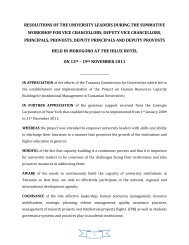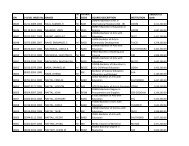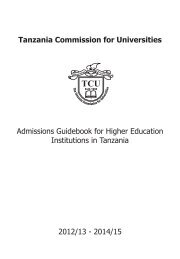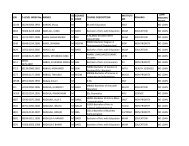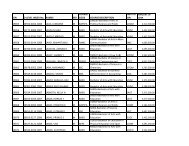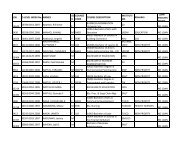Handbook for Quality Assurance in Higher Education The ... - TCU
Handbook for Quality Assurance in Higher Education The ... - TCU
Handbook for Quality Assurance in Higher Education The ... - TCU
Create successful ePaper yourself
Turn your PDF publications into a flip-book with our unique Google optimized e-Paper software.
Average time to graduation<br />
Indicate the average number of years a student spends on a program. If necessary,<br />
categorise the students <strong>in</strong> groups.<br />
- What does the department th<strong>in</strong>k of the average time to graduate?<br />
- What measures have been taken to promote graduation and to shorten the average<br />
time to graduate?<br />
- What effect have these measures had?<br />
d. Employability of the graduates<br />
<strong>The</strong> employment/unemployment rate of the graduate are <strong>in</strong> l<strong>in</strong>e with the target set<br />
by the faculty.<br />
Graduate unemployment<br />
- What percentage of graduates found a job with<strong>in</strong> six months of graduation over<br />
the past five years? How many with<strong>in</strong> a year?<br />
- What percentage of graduates are still unemployed 2 years after graduation?<br />
18. Stakeholder satisfaction<br />
<strong>The</strong> faculty/department must have a structured method to obta<strong>in</strong> feedback<br />
from all stakeholders <strong>for</strong> the measurement of their satisfaction.<br />
Explanation<br />
After analys<strong>in</strong>g the <strong>in</strong>put, the process and the output, we have to analyse the satisfaction of<br />
all stakeholders. What do they th<strong>in</strong>k about our per<strong>for</strong>mance? How do we know that? This part<br />
may cause difficulties <strong>for</strong> the department, because it may not have any tools to measure the<br />
“satisfaction rate” yet. It does not make sense to first develop tools to collect <strong>in</strong><strong>for</strong>mation<br />
with<strong>in</strong> the framework of the ongo<strong>in</strong>g analysis. It is sufficient to see that tools are miss<strong>in</strong>g and<br />
to describe how the problems might be solved <strong>in</strong> the near future.<br />
Look<strong>in</strong>g <strong>for</strong> evidence<br />
Op<strong>in</strong>ion - Students<br />
- Does the department know what students th<strong>in</strong>k about the courses, the program? <strong>The</strong><br />
teach<strong>in</strong>g? <strong>The</strong> exam<strong>in</strong>ations?<br />
- Is student evaluation carried out regularly? Is it done adequately?<br />
- What is done with the outcomes of student evaluations?<br />
- How does the department cope with compla<strong>in</strong>ts from students?<br />
Op<strong>in</strong>ion - Alumni (graduates)<br />
- Does the department <strong>in</strong>terview graduates on a regular basis?<br />
- What is the op<strong>in</strong>ion and feedback of graduates when they are employed?<br />
- Is the feedback of the alumni used to adjust the program?<br />
Guidel<strong>in</strong>es <strong>for</strong> Self Assessment<br />
33<br />
IUCEA/ CHE/ NCHE/ <strong>TCU</strong>/ DAAD



